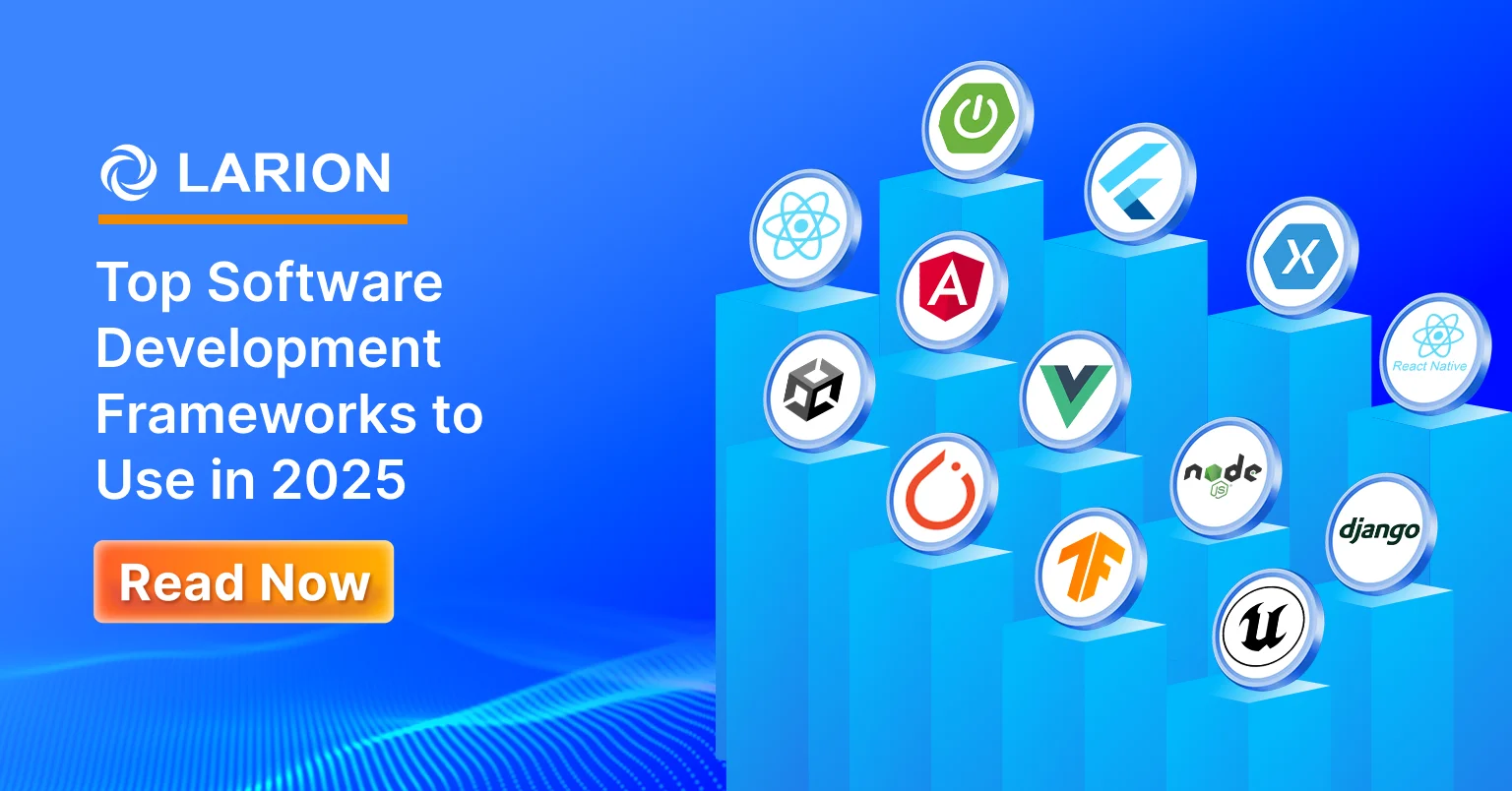
In early software development, everything had to be built from scratch, from authentication to database management, leading to inconsistencies and longer development cycles. As user demands grew in recent years, these challenges made scaling applications, debugging, and team collaboration more difficult.
Software development frameworks addressed these issues by providing standardized architectures, built-in security, and pre-configured modules for common functionalities. By simplifying the development process, software frameworks empower developers to shift their focus from repetitive coding to creating intuitive, high-performing applications that meet evolving user needs.
In this article, we’ll break down the top software development frameworks of 2025, ranking the best options in each category. We’ll dive into their key features and examine the industry trends that make them essential for the future of software development. Let’s dive in!
What is a software development framework?
A software development framework is a collection of tools and libraries that help developers build applications more quickly and efficiently. It provides reusable code blocks, enforces best practices, and handles routine configurations, allowing developers to focus on innovation rather than managing the entire development process.
Benefits of using frameworks in software development
With structured architecture, pre-built components, and best practices, frameworks greatly assist developers in their work. Key benefits include:
- Faster development cycles: Frameworks provide pre-built components and tools that simplify the coding process, accelerate developmentl, and help teams meet deadlines more efficiently.
- Security: Software development frameworks have built-in security features, such as authentication, encryption, and protection against common threats. These features reduce vulnerabilities and enhance the overall security of your application.
- Consistency: By using a software framework, developers follow consistent coding standards, making the codebase more organized and easier to maintain, especially for large teams working on large projects.
- Scalability: Most frameworks are built to support growing applications. They offer built-in solutions for managing increased traffic, data, and features without sacrificing performance.
- Community support: Popular frameworks in software development have large developer communities that provide updates, plugins, and troubleshooting assistance. This makes it easier to find solutions and stay updated on industry standards.
Criteria for selecting a software framework
With countless options available, choosing the right development framework can be overwhelming. To make the process easier, here are some essential criteria to consider:
- Performance & scalability: Choose a framework that can handle large-scale applications without compromising performance. It should also support modern architectures like microservices and be flexible enough to scale as your app grows
- Security & compliance: Select a development framework with built-in protections against threats like SQL injection, cross-site scripting (XSS), and data breaches. The framework should also meet industry standards (e.g., GDPR, HIPAA) for certain applications
- Ease of development & learning curve: A software framework should be easy to learn, with clear documentation, tutorials, and active developer support. Since frameworks are designed to work with specific programming languages, choosing one in a language your team is familiar with can reduce onboarding time and increase productivity
- Community support & ecosystem: A strong community provides better support, frequent updates, and a rich ecosystem of plugins and libraries. This helps developers quickly resolve issues and seamlessly integrate new features
- Cross-platform compatibility: If your application needs to run across multiple platforms (web, mobile, desktop), select a framework that supports cross-platform development. This minimizes development effort and ensures a consistent user experience across all platforms
Top software development frameworks
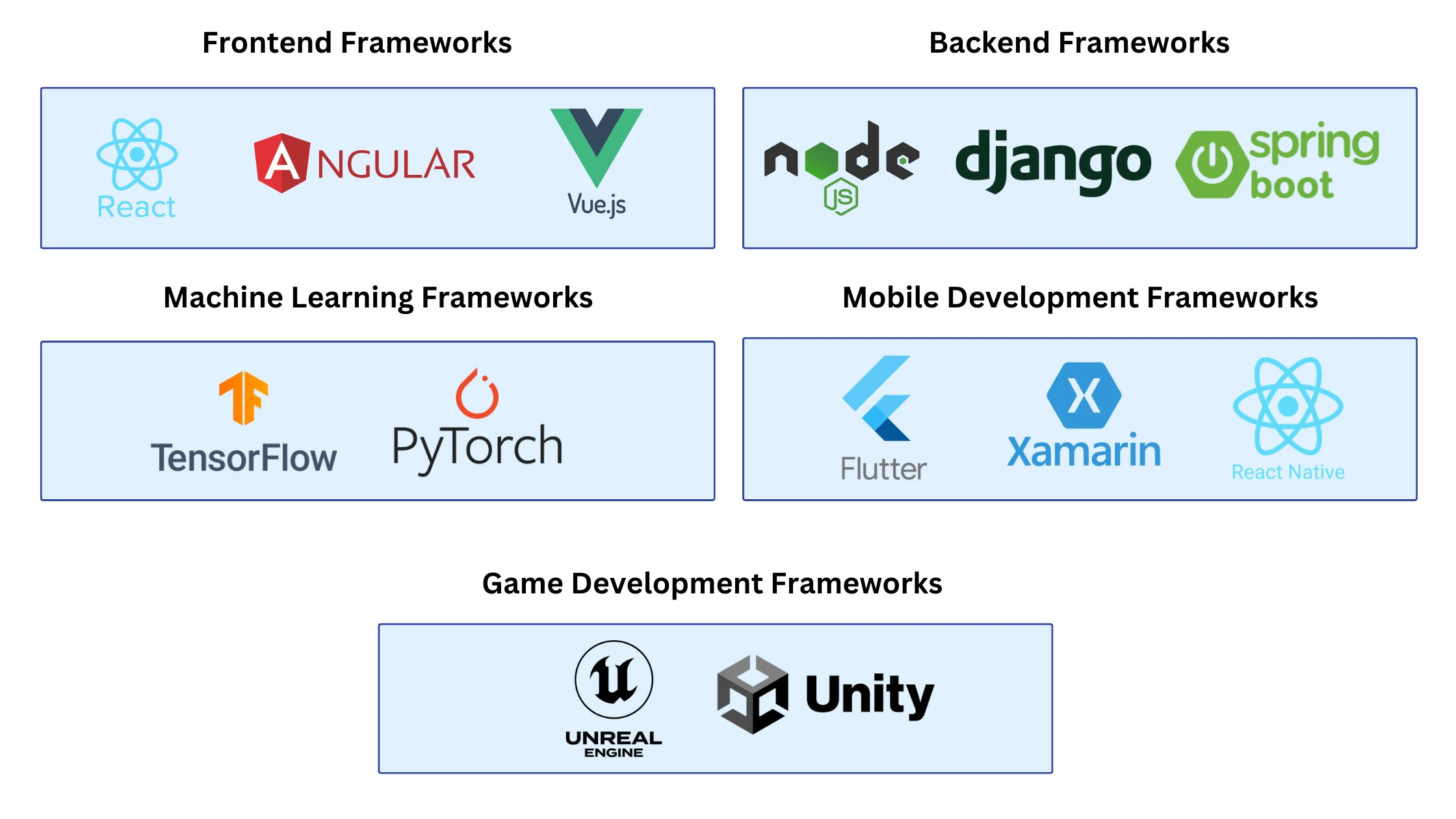
Successful software development hinges on understanding the available frameworks. Each one is designed to meet specific requirements and provides unique features tailored to different development needs.
Here’s a look at the various types of software development frameworks that play a crucial role
Frontend Frameworks
Frontend frameworks are essential tools for building modern web applications, providing developers with pre-written code, components, and structures to streamline development. They help create responsive, interactive, and visually appealing user interfaces while ensuring efficiency and maintainability
1. React.js
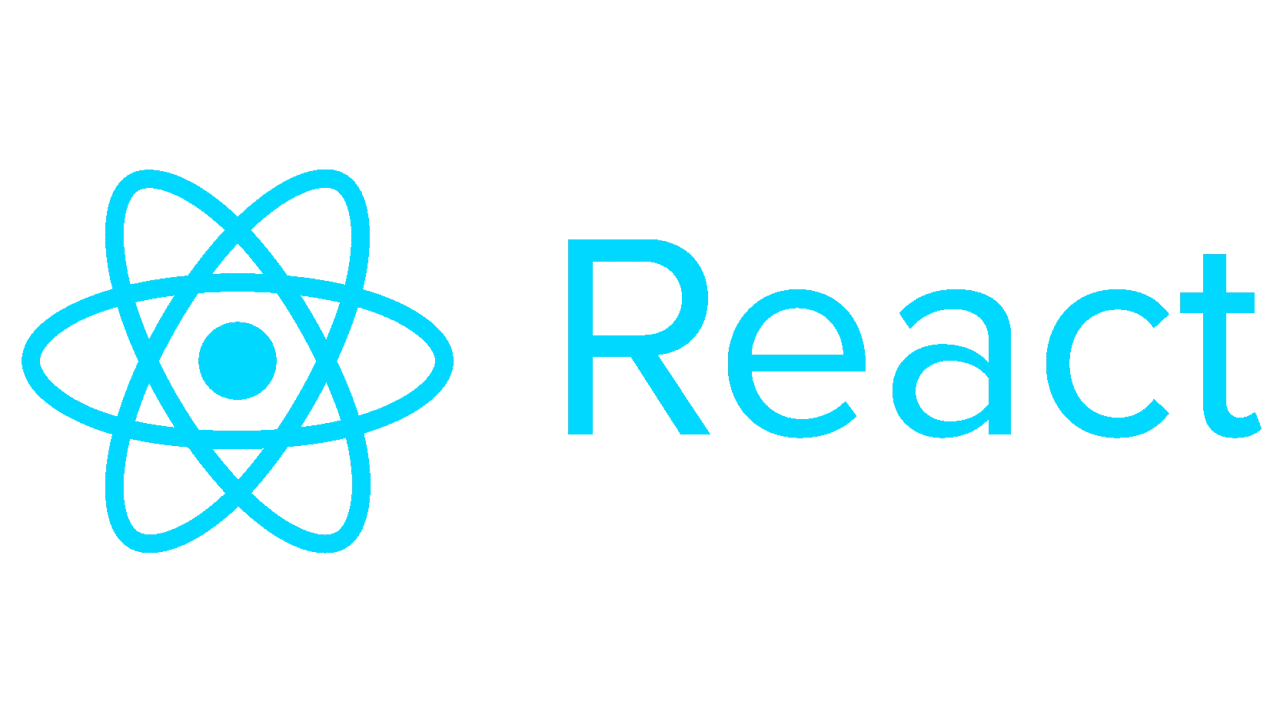
React.js, backed by Meta, continues to be a leading choice in front-end development. It simplifies the creation of reusable UI components, reducing redundant code and speeding up the development process. React also stands out because of its flexibility—whether you’re building a small widget or a full-fledged single-page application (SPA), it can easily handle both.
Key features
- Virtual DOM: Updates only the necessary parts of a page, improving speed and performance.
- Component-based architecture: Enables code reusability and modular development.
- JSX (JavaScript XML): Simplifies writing and structuring UI components.
- One-way data binding: Ensures a predictable data flow, making debugging easier.
- State management: Supports built-in state handling and external libraries like Redux for better data management.
Cons
- Complex state management: Managing state in large applications requires external libraries like Redux or Context API, adding complexity to development.
- Poor SEO by default: Since React is client-side rendered, search engines may struggle to index content unless server-side rendering (SSR) is implemented with frameworks like Next.js.
- Boilerplate code: React often requires additional setup and configurations, especially for large-scale applications.
- Lack of built-in routing: React does not have built-in routing, requiring developers to use external libraries like React Router.
Programming language
JavaScript, TypeScript
Market insights
- According to Stack Overflow’s Developer Survey, as of 2025, React.js held 40% of the front-end framework market share.
- Over 1.3 million websites use React.js to build their interfaces, and the number continues to rise.
2. Angular
Google’s Angular is a comprehensive development framework for building robust, large-scale applications. It uses TypeScript (a superset of JavaScript), which is ideal for projects requiring strong type-checking. Angular also has built-in tools for routing, forms, HTTP requests, and more, making it an excellent option for more complex projects.
Key features
- Two-way data binding: Automatically updates the UI when the data model changes, improving responsiveness.
- Component-based architecture: Encourages modular development and code reusability.
- Dependency injection (DI): Simplifies the management of services and improves testability.
- Directives: Enhances HTML by adding custom behaviours and dynamic content manipulation.
- TypeScript support: Offers strong typing, better error detection, and improved developer productivity.
Cons
- Heavy framework: Compared to React and Vue.js, Angular has a larger bundle size, which can affect performance, especially in lightweight applications
- Slower performance in small apps: While Angular performs well in large-scale applications, its complexity and additional processing can slow down smaller projects.
- Limited flexibility: Angular follows a rigid structure, which can be restrictive for developers who prefer more flexibility in designing their architecture.
Programming language
TypeScript
Market insights
- Angular is trusted by industry giants like Google and Microsoft, which proves its stability and long-term viability.
- At the beginning of 2025, Angular packages were downloaded 419,806 times, representing a 93.5% increase compared to the 216,953 downloads at the end of 2024
3. Vue.js
![]()
Vue.js has gained massive popularity due to its simplicity and ease of learning. Its components can be seamlessly integrated into existing projects. Vue is especially loved for its clean and straightforward syntax. It’s an excellent choice if you’re looking to rapidly prototype or build small to medium-scale applications with minimal overhead.
Key features
- Reactive data binding: Ensures automatic updates in the UI when data changes.
- Virtual DOM: Optimizes performance by updating only the necessary parts of a page.
- Vue router: Enables seamless navigation and single-page application (SPA) development.
- Vuex for state management: Provides a centralized way to manage application state efficiently.
Cons
- Smaller community: While Vue has a growing user base, it still has fewer contributors and resources compared to React and Angular.
- Fewer third-party plugins & tools: Compared to React and Angular, Vue has a smaller selection of third-party libraries, which can limit development options.
- Performance issues in large applications: While Vue performs well in smaller projects, managing large-scale applications with Vuex (state management) can become complex and impact performance.
Programming language
JavaScript, TypeScript
Market insights
- According to npm stats, Vue.js has been consistently downloaded around 6 million times a week over the past year
- With over 8 million websites now built using Vue, it’s become a major player in front-end development.
Backend Frameworks
Backend frameworks are crucial for developing the server-side of web applications, managing databases, authentication, APIs, and business logic. They provide structured tools and pre-built components to streamline development, enhance security, and improve performance
4. Node.js

Node.js is not just a backend framework; it’s a runtime that allows JavaScript to run on the server. What sets Node.js apart is its non-blocking, event-driven architecture, which makes it ideal for building high-performance applications such as real-time apps, streaming services, and APIs.
Key features
- Non-blocking, asynchronous processing: Handles multiple requests simultaneously, improving performance.
- Event-driven architecture: Efficiently processes real-time data and user interactions.
- Fast execution with V8 engine: Converts JavaScript into machine code for high-speed performance.
- NPM (Node Package Manager): Provides access to thousands of open-source libraries for faster development.
- Built-in APIs: Supports file system operations, networking, and data handling without external dependencies.
Cons
- Single-threaded limitations: Node.js uses a single-threaded event loop, which can struggle with CPU-intensive tasks like heavy computations or complex data processing
- Callback hell & complex asynchronous programming: Heavy reliance on callbacks for asynchronous operations can lead to “callback hell,” making code difficult to read and maintain
- Security concerns: The vast NPM ecosystem includes many open-source libraries, but some may have security vulnerabilities or lack proper maintenance.
Programming language
JavaScript, C++
Market insights
- The Stack Overflow Developer Survey consistently ranks Node.js among the top backend technologies in the list of frameworks.
- According to industry reports, it powers millions of web applications and is adopted by companies like Netflix, PayPal, LinkedIn, and Uber.
5. Django

Django, built with Python, is known for its “batteries-included” philosophy. This means it comes with many features out of the box, like authentication, database management, and routing. Django also emphasizes security, with built-in features to protect against SQL injection, cross-site scripting, and other common vulnerabilities.
Key Features
- Built-in admin panel: Provides an auto-generated interface for managing application data.
- Object-relational mapping (ORM): Simplifies database interactions using Python instead of SQL.
- Security features: Protects against SQL injection, cross-site scripting (XSS), and other threats.
- Automatic URL routing: Simplifies URL handling without requiring manual configurations.
- Third-party packages: Supports a vast ecosystem of plugins and extensions for added functionality.
Cons
- Monolithic structure: Django follows a “batteries-included” approach, which can make it overly complex for small projects that don’t require all its built-in features
- Not ideal for real-time applications: Django is not well-suited for real-time applications like chat apps or live-streaming, as it lacks built-in support for WebSockets and asynchronous processing.
Programming language
Python
Market insights
- Due to its scalability and reliability, Django is the preferred choice for large-scale applications such as Instagram, Spotify, and Mozilla.
- Django ranks among the top Python web frameworks, with over 85,000 websites using it, and its adoption continues to grow each year
6. Spring Boot

For Java developers, Spring Boot is the preferred framework in software development. It allows you to create stand-alone, production-ready, high-performance applications with minimal setup. The Spring ecosystem is vast, so if you need to integrate with other technologies, Spring has a solution.
Key features
- Auto-configuration: Reduces manual setup by automatically configuring components based on dependencies.
- Microservices support: Provides tools for developing cloud-native, modular applications.
- Spring security: Offers built-in authentication and authorization mechanisms.
- Spring data: Simplifies database interactions with JPA and NoSQL support.
- Actuator for monitoring: Helps track application health, performance, and metrics
Cons
- Larger deployment artifacts: Spring Boot packages dependencies, libraries, and an embedded server into a single JAR file, making the final artifact significantly larger. This can slow down deployment and increase storage requirements.
- Slower startup time: Due to auto-configuration and dependency scanning, Spring Boot applications can take longer to start compared to manually configured Spring applications, which can be a concern for microservices architectures
Programming language
Java, Kotlin, Groovy
Market insights
- Spring Boot is used by over 62% of Java developers for backend applications.
- 90% of Fortune 500 companies leverage this software framework for enterprise-grade solutions
Machine Learning Frameworks
Machine learning frameworks provide the tools and libraries needed to build, train, and deploy machine learning models efficiently. They simplify complex tasks like data preprocessing, model optimization, and neural network training, enabling developers and data scientists to focus on innovation
7. TensorFlow
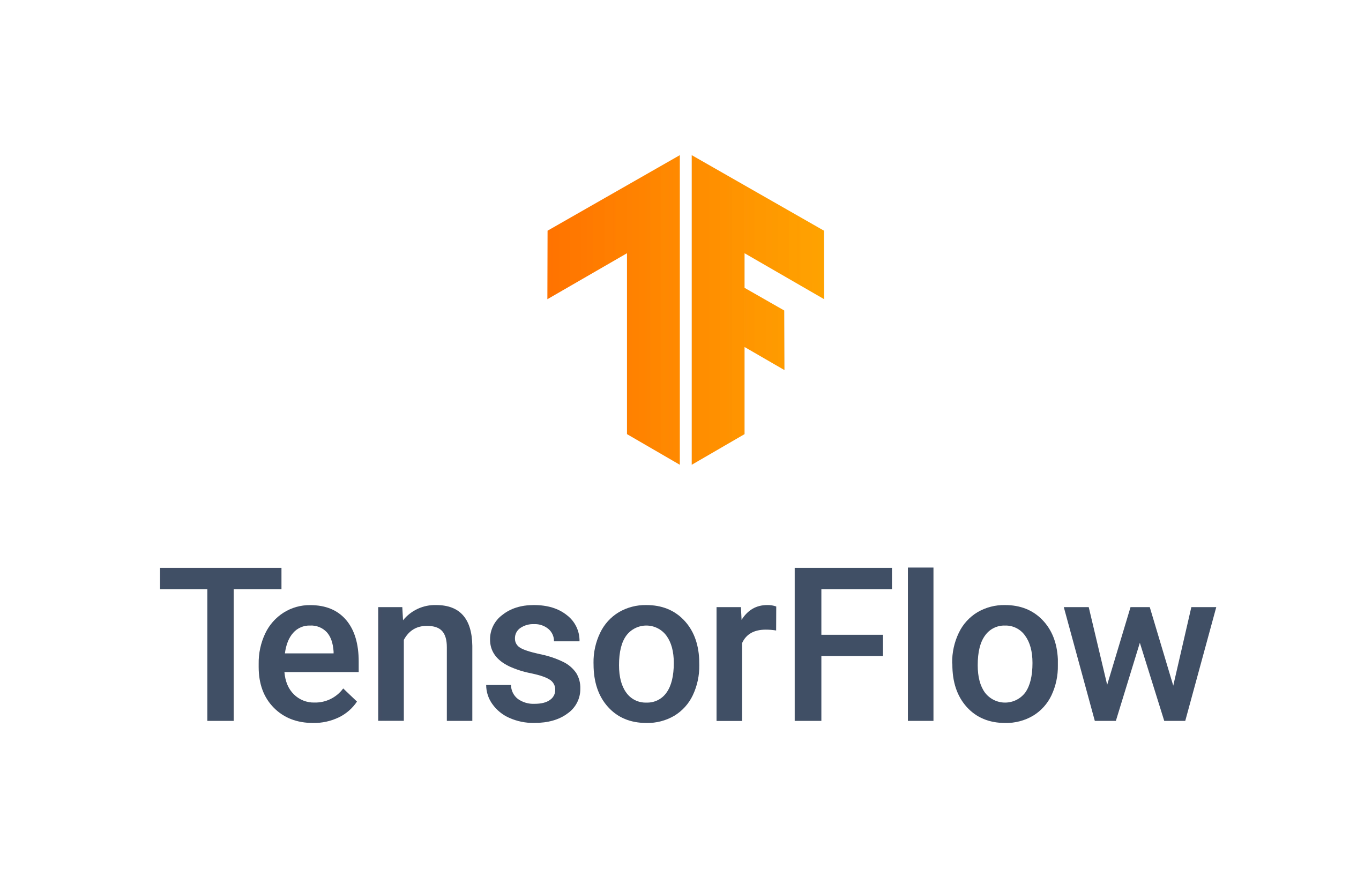
Developed by Google, TensorFlow is a deep learning framework widely used for building AI models, neural networks, and large-scale machine learning applications. It supports GPU acceleration and provides flexibility for research and production deployment.
Key features
- Computational Graphs: TensorFlow uses dataflow graphs to represent computations, allowing for efficient parallel processing and distribution of workloads across multiple devices (CPUs, GPUs, TPUs)
- Deep Learning Focus: Provide extensive support for building and training neural networks (CNNs, RNNs, transformers, GANs and more)
- Keras Integration: Seamlessly integrate with high-level API Keras
Cons
- Steep Learning Curve: TensorFlow has a complex structure, making it difficult for beginners to grasp compared to other frameworks like PyTorch.
- Verbose Syntax: Writing TensorFlow code often requires more lines than other frameworks, making it less intuitive for rapid prototyping.
- Difficult Debugging – Debugging can be challenging due to static computation graphs (especially in older versions) and less readable error messages.
- High Resource Consumption – TensorFlow requires significant computational power, making it less efficient for low-end hardware or mobile devices
Programming language
C++, JavaScript, Go
Market insights
- Nearly 55% of organizations use TensorFlow for machine learning tasks
- Widely used by major tech firms like Google, Meta, OpenAI, and Microsoft
8. PyTorch

Developed by Facebook’s AI Research lab (FAIR), PyTorch is another popular open-source machine learning framework. It is renowned for its dynamic computation graph and Pythonic nature, making it highly favored in academic and research settings.
Key features
- Dynamic Computation Graphs – Unlike static graphs in TensorFlow, PyTorch’s computation graphs are dynamic, allowing for on-the-fly modifications and easier debugging.
- Pythonic & Intuitive API – Designed with a user-friendly, Pythonic interface that seamlessly integrates with Python libraries like NumPy and SciPy.
- Deep Learning Flexibility – Ideal for complex deep learning tasks, including computer vision, natural language processing (NLP), and reinforcement learning.
Cons
- Less optimized for production: While PyTorch is great for research and prototyping, TensorFlow is often preferred for large-scale production deployments due to its mature serving framework
- Higher memory consumption: PyTorch can consume more GPU memory compared to TensorFlow, making it less efficient for resource-constrained environments
- Slower training on large datasets: PyTorch can be slower than TensorFlow for large-scale distributed training, especially in highly optimized enterprise environments.
Programming language
Python, C++
Market insights
- As of 2024, over 75% of researchers preferred PyTorch for implementing machine learning models, reflecting its stronghold in academia
- In 2024, contributions came from over 3,500 individuals and 3,000 organizations, a significant increase from just 200 organizations two years prior
Mobile App Development Frameworks
Mobile app development frameworks simplify the process of building native, hybrid, or cross-platform applications by providing essential tools, libraries, and pre-built components. They enhance efficiency, streamline UI design, and ensure compatibility across various devices and operating systems. For optimal performance, you should also important to explore mobile programming languages that pair with these frameworks
9. Flutter

Google’s Flutter is an open-source UI toolkit for building natively compiled mobile, web, and desktop applications from a single codebase. Its standout feature is its ability to create beautiful, high-performance apps with customizable widgets. Additionally, the “hot reload” feature allows developers to see changes in real-time, speeding up development.
Key features
- Fast performance: Uses a high-speed rendering engine (Skia) for smooth animations and quick UI updates.
- Hot reload: Instantly applies code changes without restarting the app, boosting development speed.
- Rich UI components: Provides customizable widgets for building beautiful, responsive designs.
- Dart language: Ensures high performance with just-in-time (JIT) and ahead-of-time (AOT) compilation.
- Strong community & Google support: Regular updates and a vast ecosystem of plugins.
Cons
- Large app size: Flutter apps tend to be larger than native apps because they bundle the Flutter engine, Dart runtime, and necessary libraries within the app. This increases download size and storage requirements.
- Limited native features & libraries: While Flutter provides many plugins, it still lacks some native features or third-party integrations that are easily available in native Android (Kotlin/Java) or iOS (Swift/Objective-C) development. Sometimes, developers need to write platform-specific code using platform channels
- Slower performance for certain use cases: Although Flutter offers high performance, it may struggle with very complex animations, high-end gaming, or apps that require extensive background processing. Native solutions can sometimes be more optimized in these cases.
Programming language
Dart
Market insights
- Flutter adoption has increased by 46% in the past year due to its performance advantages.
- Over 1,000,000 mobile applications have been developed using Flutter so far
10. React Native
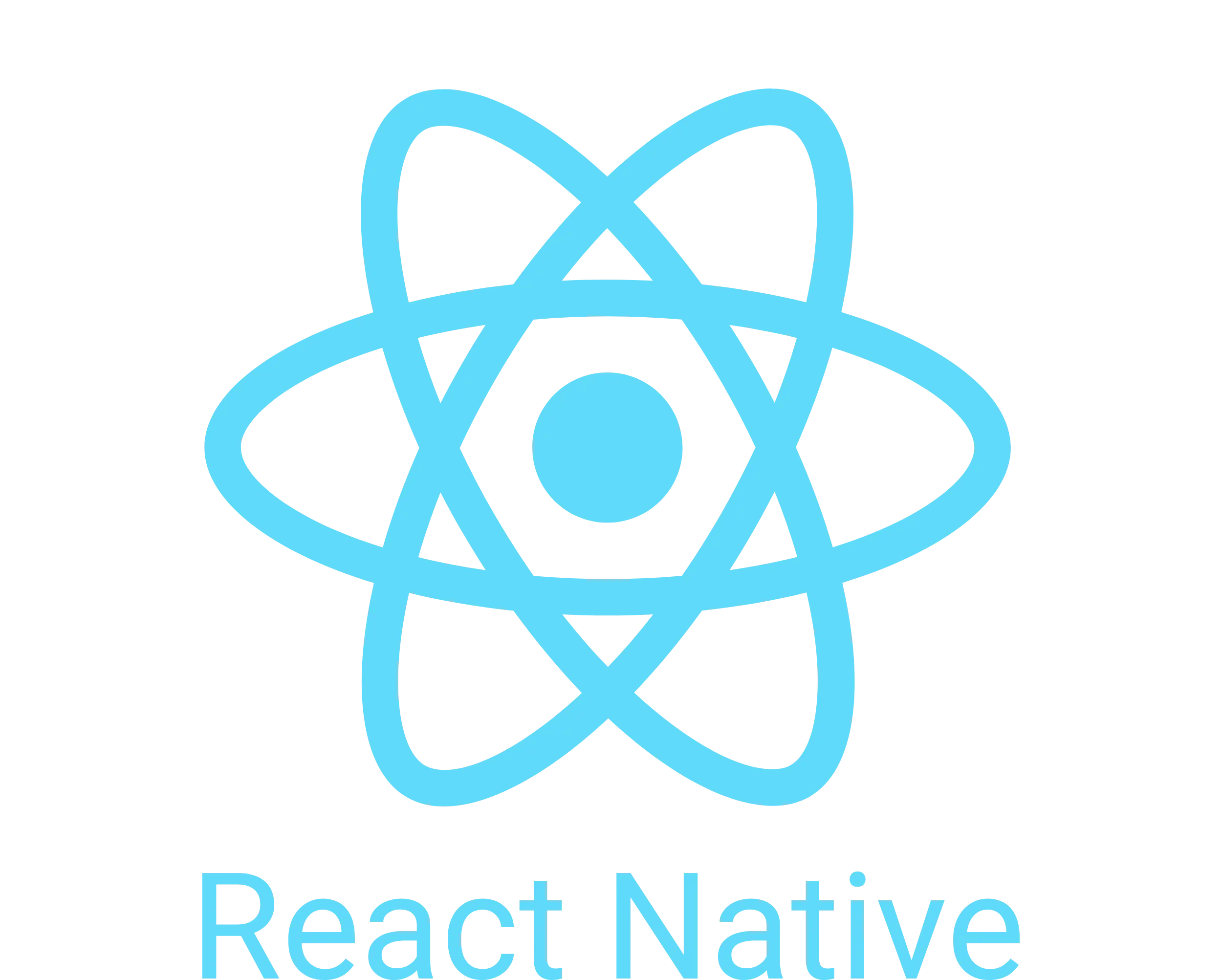
The list of frameworks is incomplete without React Native. Developed by Facebook, this software framework allows you to use JavaScript to build mobile apps for iOS and Android. It is ideal if you’re already using React.js on the front end of your website, as you can apply the same knowledge and components to mobile app development. React Native offers performance close to native apps, making it a solid choice for most app developers.
Key features
- Cross-platform compatibility: Write app code once and run on both iOS and Android.
- Native-like performance: Uses actual native components, delivering a smooth user experience.
- Hot reloading: Instantly reflects code changes without restarting the app.
- Reusable components: Promotes modular development, saving time and effort.
- Third-party plugin support: Allows easy integration with existing native code and libraries.
Cons
- Dependency on native modules: While React Native provides many built-in components, some features still require writing native code. If a required module isn’t available in the React Native ecosystem, developers must create custom native modules in Swift, Objective-C, Java, or Kotlin.
- Debugging challenges: Debugging React Native applications can be more complex compared to native development. Issues related to the React Native bridge, third-party dependencies, or async JavaScript behavior can be difficult to trace
Programming language
JavaScript, TypeScript
Market insights
- On average, over 37% of developers prefer React Native for cross-platform mobile app projects
- React Native is trusted by major companies like Facebook, Instagram, and Airbnb for their mobile apps
11. Xamarin
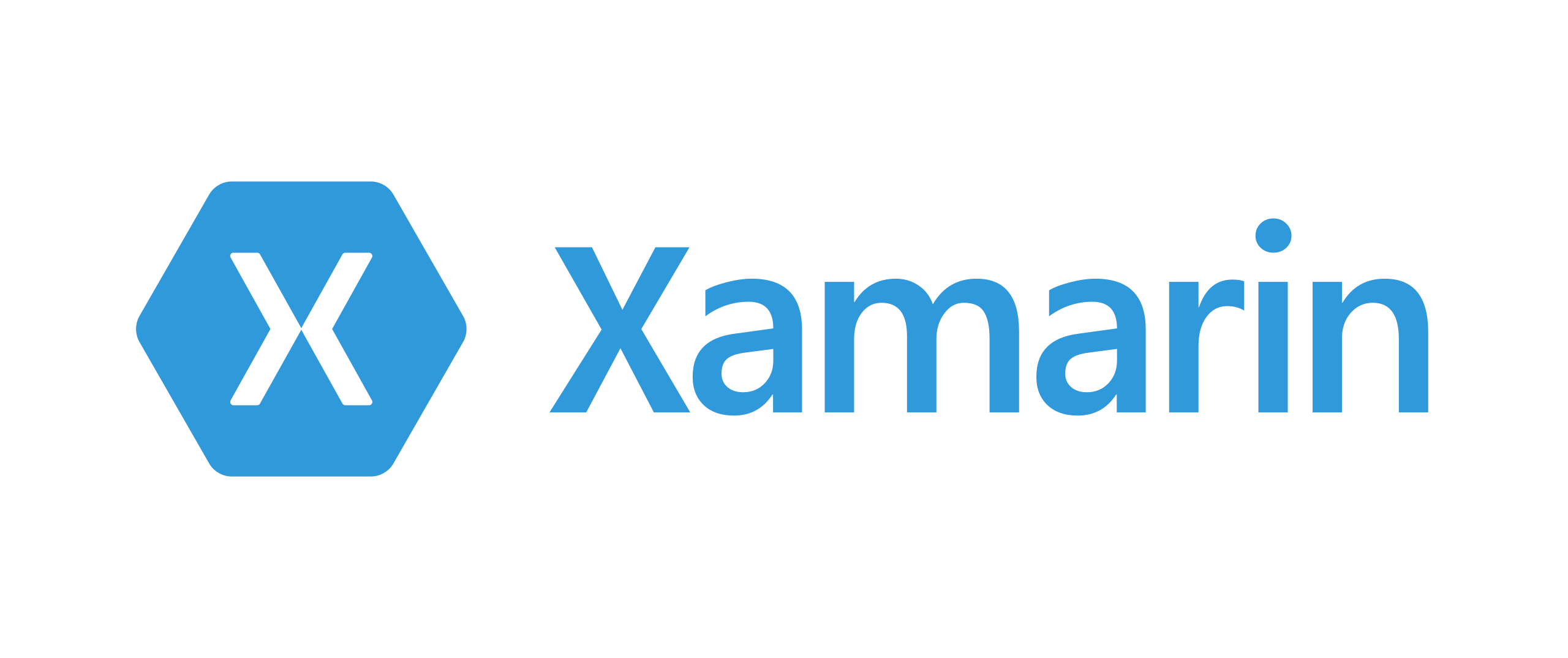
If you’re a .NET developer, Xamarin is an excellent software framework for building cross-platform mobile apps. Owned by Microsoft, Xamarin lets you write your app’s code in C# and share it across Android, iOS, and Windows devices. It’s ideal for those who want to leverage the .NET ecosystem while targeting multiple platforms with minimal code duplication.
Key features
- Single codebase: Write one C# codebase and deploy it across iOS, Android, and Windows, reducing development time.
- Xamarin forms: A UI toolkit for building cross-platform user interfaces with shared code.
- Seamless .NET integration: Works well with Visual Studio, Azure, and other Microsoft tools.
- Strong Microsoft support: Regular updates, detailed documentation, and a vast developer community ensure long-term reliability.
Cons
- Limited community: While C# and .NET have strong ecosystems, Xamarin has a smaller community compared to React Native or Flutter. Some third-party libraries may not be available or fully compatible with Xamarin
- Microsoft dependency: Xamarin is owned by Microsoft, and with the transition to .NET MAUI (Multi-platform App UI), Xamarin’s future is uncertain. Developers need to migrate to .NET MAUI, which may involve code refactoring
Programming language
C#, .NET
Market insights
- Enterprises prefer Xamarin due to its tight integration with Microsoft technologies.
- Over 15,000 organizations and more than 1 million programmers worldwide use Xamarin
Game Development Frameworks
Game development frameworks simplify tasks like graphic rendering, physics simulation and game logic, allowing developers to focus on creativity and gameplay design.
12. Unity
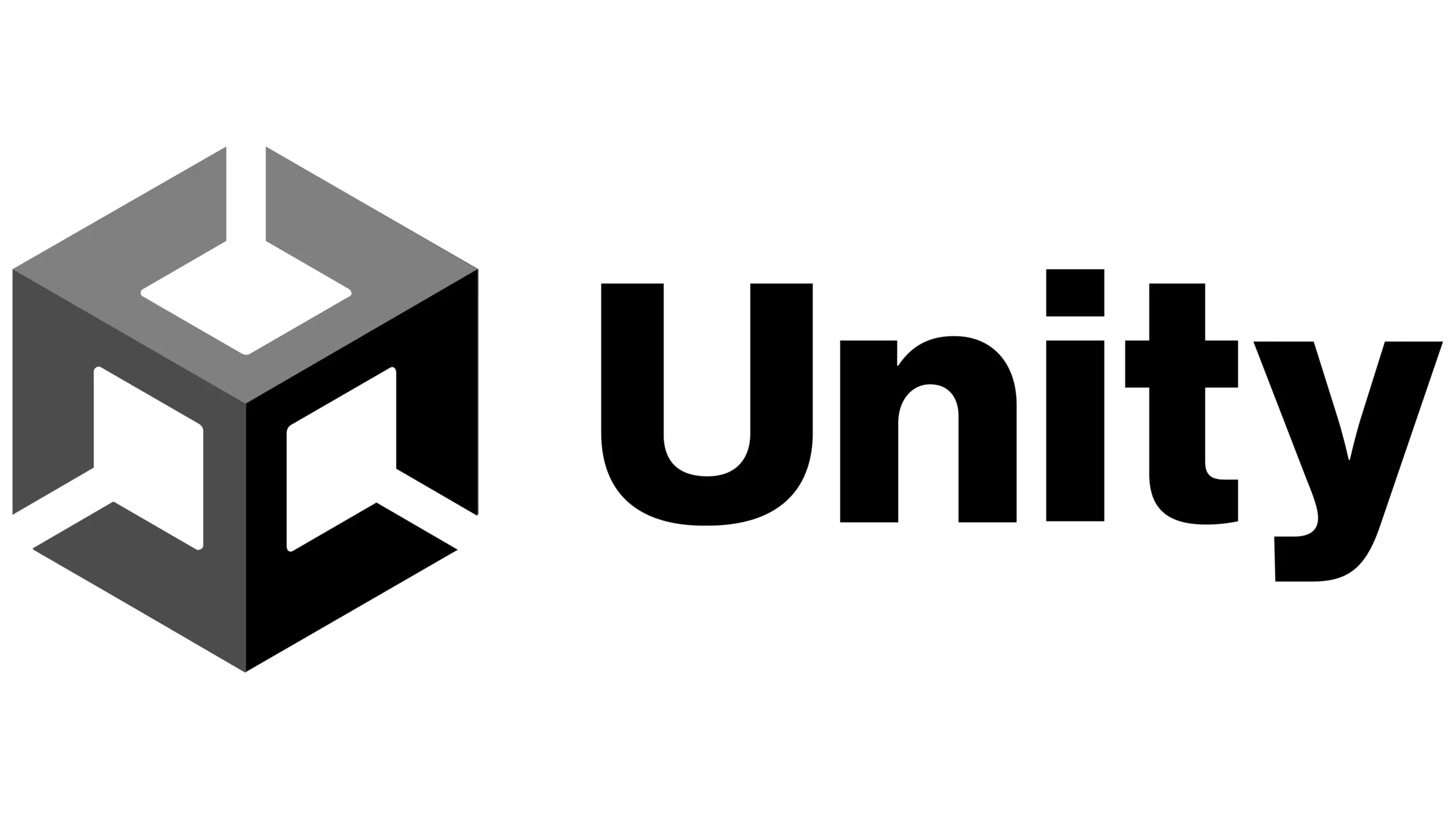
With continuous evolution and extensive features, Unity continues to reinforce its status as leading game development frameworks. Known for its versatility, it caters to everything from simple mobile games to complex 3D projects on consoles and VR platforms
Key features
- Cross-platform support: Develop once and deploy to 25+ platforms, including PC, mobile, consoles, AR/VR, and WebGL.
- Rich asset store: Offers over 65,000 pre-built assets, scripts, and tools to speed up development
- Ease of use: Unity’s user-friendly interface and visual scripting make it accessible to developers of all experience levels.
Cons
- Performance issues: Unity is not always the most optimized engine, especially for high-end AAA games. It may require extra work to achieve the same performance as Unreal Engine
- Less control over rendering: Unlike engines like Unreal, Unity doesn’t provide deep access to low-level rendering features, making it harder to optimize visuals
Programming language
C#
Market insights
- Unity powers 29.6% of games in the industry
- A Cornell University study found that Unity is 351% more energy-efficient in physics simulations and 17% more efficient in static meshes, while Unreal Engine outperforms it by 26% in dynamic meshes.
13. Unreal Engine

Developed by Epic Games, Unreal Engine has seen significant growth and adoption, especially after the release of Black Myth: Wukong. Recognized for its cutting-edge visuals and robust toolset, it empowers developers to build immersive and captivating gaming experiences.
Key features
- Next-gen graphics & rendering: Features Lumen (real-time lighting) and Nanite (virtualized geometry) for ultra-realistic visuals.
- Cross-platform development: Supports PC, consoles, mobile, AR/VR, and cloud gaming.
- Advanced animation: Features a powerful Skeletal Editor and Motion Matching technology, enabling smoother and more realistic character animations
Cons
- Steep learning curve: With its vast features and capabilities, the platform can be difficult for newcomers, demanding considerable time and effort to master.
- Hardware requirements: Unreal Engine’s advanced capabilities demand powerful hardware, posing a challenge for smaller teams or developers with limited resources.
Programming language
C++
Market insights
- Holds approximately 16.6% of the game development market share
- 48% of announced next-generation games are being built using Unreal Engine
- Popular in AA game studios, film production and architecture
| Frameworks | Pros | Cons | Use Cases | |
| Frontend
Frameworks |
1. React.js | Fast, component-based, huge ecosystem | SEO challenges, requires build configuration | Single-page applications, progressive web apps, dynamic UIs |
| 2. Angular | Complete package, two-way data binding, strong community | Steep learning curve, slower initial setup | Enterprise-level apps, SPAs, dashboards & admin panels | |
| 3. Vue.js | Simple, lightweight, flexible | Smaller community than React/Angular | Progressive web apps, small to medium-sized apps | |
| Backend Frameworks | 4. Node.js | Non-blocking, fast, vast NPM ecosystem | Not suitable for CPU-intensive tasks | IoT applications, microservices architecture, Restful & GraphQL APIs |
| 5. Django | Batteries-included, secure, Python-based | Can be slow for lightweight apps | Content management systems, data-driven apps | |
| 6. Spring Boot | Microservices-friendly, enterprise-grade security | Java-heavy, can be complex for beginners | Enterprise solutions, cloud-based platforms, banking & FinTech apps | |
| Machine Learning Frameworks | 7. TensorFlow | Strong production support, rich ecosystem | Steeper learning curve, verbose syntax and slower debugging 1 | Large-scale ML, enterprise AI |
| 8. PyTorch | Intuitive API, dynamic computation and fast prototyping | Less mobile support, higher memory usage | Research models, computer vision and NLP applications | |
| Mobile App Development Frameworks | 9. Flutter | Native performance, single codebase, rich widgets | Limited library support compared to native apps | Prototypes, business apps, on-demand service apps, desktop applications |
| 10. React Native | Reusable components, active community, fast development | Native modules sometimes require additional code | Social media apps, e-commerce platforms, MVPs | |
| 11. Xamarin | Native performance, C# integration, strong Microsoft support | Less popular, small community | Enterprise & business apps, Microsoft-focused solutions | |
| Game Development Frameworks | 12. Unity | Easy to learn, large asset store, wide platform support | Weaker graphics, performance limitations | AR/VR development, mobile games |
| 13. Unreal Engine | High-end graphics, free for indies, powerful physics | Steeper learning curve and higher system requirements | AAA games, Cinematic rendering, architectural visualization | |
Wrap-Up
Whether you’re developing for the frontend, backend, machine learning, game development or mobile platforms, choosing the correct framework is crucial to your software’s success.
React.js, Angular, and Vue.js are leaders in the frontend space, while Node.js, Django, and Spring Boot dominate backend development. For mobile apps, Flutter, React Native, and Xamarin provide outstanding cross-platform solutions. In the realm of data science, TensorFlow and PyTorch are top choices, while Unity and Unreal Engine are the go-to frameworks for game development.
With frameworks constantly evolving, selecting the right one depends on your project scope and expertise. At LARION, we help you navigate these choices and find the best fit for your needs.
Contact us today to explore the best solutions tailored to your needs!





